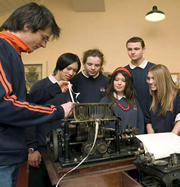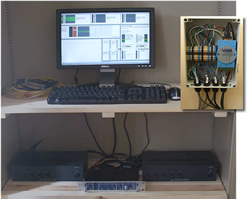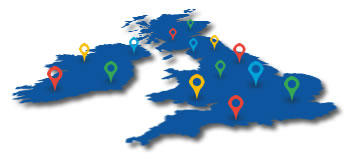 The launch of the Porthcurno Sculpture Garden on May 28, 2009 officially unveiled a series of new large-scale art works – co-created by renowned artists and Cornish schoolchildren – that freshly articulate the invisible science behind telegraphic technology and celebrate Porthcurno’s surprisingly key role in world history.
The launch of the Porthcurno Sculpture Garden on May 28, 2009 officially unveiled a series of new large-scale art works – co-created by renowned artists and Cornish schoolchildren – that freshly articulate the invisible science behind telegraphic technology and celebrate Porthcurno’s surprisingly key role in world history.
Libby Buckley – who became Museum Director two years ago – says: “It’s known chiefly as a place of great coastal beauty now, but Porthcurno made scientifically and historically important waves during the global communications revolution from 1870 onwards.
“This was the site of the first successful cable established between Britain and India in 1870, it subsequently became the hub of the British Empire’s communications network, and was a place which hosted and led enormous advancements in the technology of the time. It’s incredible to think of now, but Porthcurno really was the Silicon Valley of its age.”
The real stories behind Porthcurno’s key (yet almost forgotten) role in global development is described in rich detail in the Museum’s exhibitions, housing the most comprehensive collection of early cable technology in the world and comprising a wealth of original telegraphic equipment right through to contemporary fibre-optics.
 ‘Soundings’, a NESTA (National Endowment for Science, Technology and the Arts) funded dynamic sound installation from Scots artist and engineer Renny Nisbet was among the new works. A continually changing sound-scape is generated from live signals on a redundant submarine telegraph cable which once connected the UK with Vigo, Spain. Though no longer in use, the cable now acts as a giant antennae on the seabed, detecting very-low-frequency atmospheric radio signals from global lightning and man-made sources. The cable also produces DC from fluctuations in the Earth’s magnetic field due to solar influences. These signals are amplified at a remote hut overlooking the beach where the sea-cable is terminated. From here the signals are transmitted to processing equipment within the Museum where corresponding audio is generated in real-time. The live audio can be heard within the cable-house and at a sound-pole within the Museum grounds.
‘Soundings’, a NESTA (National Endowment for Science, Technology and the Arts) funded dynamic sound installation from Scots artist and engineer Renny Nisbet was among the new works. A continually changing sound-scape is generated from live signals on a redundant submarine telegraph cable which once connected the UK with Vigo, Spain. Though no longer in use, the cable now acts as a giant antennae on the seabed, detecting very-low-frequency atmospheric radio signals from global lightning and man-made sources. The cable also produces DC from fluctuations in the Earth’s magnetic field due to solar influences. These signals are amplified at a remote hut overlooking the beach where the sea-cable is terminated. From here the signals are transmitted to processing equipment within the Museum where corresponding audio is generated in real-time. The live audio can be heard within the cable-house and at a sound-pole within the Museum grounds.
The signals present in the extensive submarine cable are of a very low frequency and, as such, are inherently demanding of the analogue to digital convertor. In this case the RME ADI-2 fitted the bill perfectly with a frequency range of 5Hz to 21.5kHz (analogue to digital) and 1Hz to 21.1kHz (digital to analogue), at a sampling rate of 44.1kHz. The quality of the convertors not only impresses studios and hi-fi audiophiles but can also adapt to the most demanding of applications.
Renny Nisbet adds: “The Museum’s collections have provided a rich background of fascinating and historic source material to work from; spanning the entire development of modern communications to the present age of instantaneous global communication we may often take for granted.”
Read the Sound On Sound RME ADI-2 review
 Porthcurno Telegraph Museum and the Porthcurno Sculpture Garden are owned and run by The PK Trust, an independent educational charity set up in 1997 by Cable & Wireless to preserve the important historical buildings and collections at Porthcurno, the home of the British Empire’s first international telecommunications network.
Porthcurno Telegraph Museum and the Porthcurno Sculpture Garden are owned and run by The PK Trust, an independent educational charity set up in 1997 by Cable & Wireless to preserve the important historical buildings and collections at Porthcurno, the home of the British Empire’s first international telecommunications network.
A major telegraph station and training centre which stood at the very heart of the world’s communications network for 100 years until 1970, Porthcurno was deemed so important by Churchill during WWII that he requested the station was fortified underground in 1941 to protect it from enemy attack. Here, the major submarine telecommunications cables still reach land, carrying millions of messages daily between the UK and the world.
The PK Trust also manages the Cable & Wireless historic archive of photographs, films & documents. Through providing access to these unique, world-class historical resources, the PK Trust is developing Porthcurno’s reputation as an important centre for the study of the history of communications. Generously supported by Cable & Wireless, grants and a team of staff and volunteers, including many retired C&W engineers, who maintain and operate the historic equipment, provide talks and tours and give the museum its great atmosphere.
The Porthcurno Sculpture Garden and Telegraph Museum is open all year round; see www.porthcurno.org.uk for details and opening times, directions and usual entry prices.
By Rob Masters





















